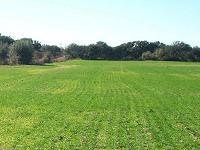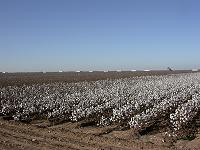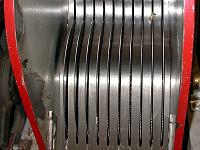

December 1, 2004 |
 |
|---|
Cool soil temperatures and additional rain in November has impacted the availability of nutrients to newly emerged wheat and this will reduce the potential plant development. The plant will suffer until the root expands far enough to extract the deeper nitrates or until an application of nitrogen is made. The older wheat has a deeper root system and has developed a significant amount of forage. The lush, rapidly growing wheat will be vulnerable to a freeze. The impact of a freeze on this susceptible wheat will be tip burn which will give the field a yellowish bronze color; however, the wheat will return to a green color in a couple of weeks as the injured leaves are hidden by the new plant growth.
There are several dead and injured leaves on the developing wheat and it is causing producers some concern. The leaf damage is generally due to insects (aphids) and disease (leaf rust). Grazing of wheat is an alternative to pesticide use in reducing insect populations and fungus development. Grazing of wheat should be delayed until the secondary root system has developed enough to anchor the plant. If producers start the grazing process too early, the livestock will pull the wheat plant up by the roots and reduce the plant population.
 An inadequate amount of nitrogen is available in some small grain acreage. When the need for nitrogen is not met, small grain plant growth is slower than expected and plant coloration is light green to yellow. An application of nitrogen should be beneficial, however, producers should give special consideration to the type of fertilizer applied. The best choice is going to be ammonium nitrate because half of the nitrogen is in a form that is available to the plant at the time of application. This results in a quick response to the fertilizer applied. Other types of fertilizer have to be converted to a form used by the plant and this conversion is slowed by the cool temperatures. Two considerations when applying fertilizer to small grains: 1) dry fertilizer in contact with a wet soil surface has the potential of releasing nitrogen to the atmosphere instead of being tied up on the clay particles or organic matter. 2) If cattle will be grazing shortly after the fertilizer is applied it may cause some serious health problems, even death.
An inadequate amount of nitrogen is available in some small grain acreage. When the need for nitrogen is not met, small grain plant growth is slower than expected and plant coloration is light green to yellow. An application of nitrogen should be beneficial, however, producers should give special consideration to the type of fertilizer applied. The best choice is going to be ammonium nitrate because half of the nitrogen is in a form that is available to the plant at the time of application. This results in a quick response to the fertilizer applied. Other types of fertilizer have to be converted to a form used by the plant and this conversion is slowed by the cool temperatures. Two considerations when applying fertilizer to small grains: 1) dry fertilizer in contact with a wet soil surface has the potential of releasing nitrogen to the atmosphere instead of being tied up on the clay particles or organic matter. 2) If cattle will be grazing shortly after the fertilizer is applied it may cause some serious health problems, even death.
Broadleaf weed control may already be needed on several of the fields. If producers plan to use a hormone herbicide such as 2,4-D to control the weeds, they will need to read the label for information concerning herbicide application timing. Most of the 2,4-D labels indicate that the wheat needs to be past the tillering stage before applying the herbicide. You may need to switch over to some other class of herbicide (example: Ally or Amber).
The rainfall received helped to build soil moisture reserves, however it did delay planting of small grains on about 35 percent of the acreage. The impact of this delay will result in a few phone calls from producers to you. Most likely questions to expect: 1) How long will it take for my small grain to germinate and emerge? With these cool temperatures it will take several weeks for the newly planted acreage to obtain a green cast to it. 2) Why are my plants purple? Due to the cool soil temperatures and the slow plant growth the uptake of phosphorus will be slow and the red to purple coloration will be primarily due to nutrient deficiency. 3) Why isn't the wheat tillering? Tillering is faster when soil temperature is warm and soil moisture and nutrient levels are good–we have the soil moisture but lack the other factors needed. The impact of this will be apparent next spring when the number of tillers per plant will be less than desired. 4) I have a lot of weeds what should I do? The cool air temperatures and slow plant growth will slow the performance of the herbicides applied. Target herbicide application based on the small grain growth stage, as soon as the minimum growth stage is reached apply the product that will control the targeted weed. You can expect the root development of this late planted small grain to be low. This will make the plants vulnerable to hot, dry, windy conditions in the spring.
Considerations of late planted wheat:
 The rainfall in November delayed harvest and we have approximately 90 percent of the cotton remaining on the stalk. Problems that are apparent in the late planted acreage is the high leaf to lint ratio, which will probably result in a high leaf grade and a major discount. The next problem is too much cotton to harvest before the plant starts to breakdown. After about 14 days the plant will become more difficult to harvest and more bark will be removed in the harvesting of the crop. Producers will have to consider going to all brushes and tagging 3 to 4 percent to avoid getting barky grades. Barky grade discounts have been ranging from 3 to 7 cents a pound.
The rainfall in November delayed harvest and we have approximately 90 percent of the cotton remaining on the stalk. Problems that are apparent in the late planted acreage is the high leaf to lint ratio, which will probably result in a high leaf grade and a major discount. The next problem is too much cotton to harvest before the plant starts to breakdown. After about 14 days the plant will become more difficult to harvest and more bark will be removed in the harvesting of the crop. Producers will have to consider going to all brushes and tagging 3 to 4 percent to avoid getting barky grades. Barky grade discounts have been ranging from 3 to 7 cents a pound.
I know producers will be in a hurry to get into the field and harvest this cotton. They need to be careful not to pack lint with a high moisture content into modules. The concern is that the modules will become hot and could start burning. If the gin is behind in picking up and processing modules, the best advice is to be patient and wait for the lint to dry.
I have already heard from two cottonseed companies that seed supplies are going to be limited on some varieties in 2005 because seed blocks were lost to weather delays. Producers should check with there seed supplier and book early if the variety they want is limited. Otherwise they may have to plant an untested variety on their farm.
 The ginning date for District 6 has been reset to December 14. The ginning date for District 7 has been reset to December 13. If you can assist in ginning cotton, please let me know. We usually need four people to get the job done. I need to let all the cotton producing counties know who is going so they can make the necessary arrangements to drop off their gin samples. Linked is a blank gin sheet that will need to be filled out and sent with your cotton samples. The seven-digit sample number is a combination of three numbers: the county number is the first three digits, the producer or plot number is digits 4 and 5, and the sample is assigned a number between 01 and 99 which makes up digits 6 and 7. By using this code, it helps to keep samples from getting lost. Try to have your gin samples between 600 and 650 grams. Thanks.
The ginning date for District 6 has been reset to December 14. The ginning date for District 7 has been reset to December 13. If you can assist in ginning cotton, please let me know. We usually need four people to get the job done. I need to let all the cotton producing counties know who is going so they can make the necessary arrangements to drop off their gin samples. Linked is a blank gin sheet that will need to be filled out and sent with your cotton samples. The seven-digit sample number is a combination of three numbers: the county number is the first three digits, the producer or plot number is digits 4 and 5, and the sample is assigned a number between 01 and 99 which makes up digits 6 and 7. By using this code, it helps to keep samples from getting lost. Try to have your gin samples between 600 and 650 grams. Thanks.
The Beltwide Cotton Conference will be held in New Orleans, Louisiana, January 4 - 8, 2005. This is an excellent meeting for increasing your knowledge about cotton production. The shorten format should be more conducive to all participants.
Linked are summaries of all the weed control tests conducted in 2004.
On December 7, a five-hour CEU course will be held at the Texas A&M Agricultural Research and Extension Center in San Angelo. This training is being hosted by Texas Department of Agriculture and Texas Cooperative Extension. The target audience is Right-of-Way certified applicators. For more details and to register for the meeting call the Tom Green County Extension Office (325) 659-6522. For a copy of the agenda click here.
On December 7, a five-hour CEU course will be held at Burnet. This training is being hosted by Texas Cooperative Extension and the Texas Department of Agriculture. The target audience is ag producers and home owners. For more details and to register for the meeting call Wade Hibler at (512) 756-5463.
On December 8, a SPCB/TDA Conference will be held at the Abilene Civic Center. This training is being hosted by the City of Abilene, Texas Cooperative Extension, and the Texas Department of Agriculture. The target audience is Landscape/Turf. For more details and to register for the meeting call Gary Bomar at (325) 672-6048.
On December 15, a five-hour CEU course will be held at the Taylor County Extension Office. This training is being hosted by Texas Cooperative Extension and the Texas Department of Agriculture. The target audience is ag producers and home owners. For more details and to register for the meeting call Gary Bomar at (325) 672-6048.
 December 2, Comanche County, Crop Physiology and Management
December 2, Comanche County, Crop Physiology and Management
 December 3, District Office, Southern Rolling Plains Cotton Growers Meeting
December 3, District Office, Southern Rolling Plains Cotton Growers Meeting
 December 6, District Office, Office Conference
December 6, District Office, Office Conference
 December 6, Tom Green County, Friends of Extension Luncheon
December 6, Tom Green County, Friends of Extension Luncheon
 December 7, Burnet County, CEU Course
December 7, Burnet County, CEU Course
 December 7, Tom Green County, CEU Course--Right of Way
December 7, Tom Green County, CEU Course--Right of Way
 December 8, Taylor County, SPCB/TDA Course--Landscape/Turf
December 8, Taylor County, SPCB/TDA Course--Landscape/Turf
 December 9, Nolan County, Establish Weed Control Test
December 9, Nolan County, Establish Weed Control Test
 December 13 & 14, Lubbock County, Gin Cotton
December 13 & 14, Lubbock County, Gin Cotton
 December 15, Taylor County, CEU Course
December 15, Taylor County, CEU Course
 December 16, Tom Green County, Office Meeting
December 16, Tom Green County, Office Meeting
 December 21 - 31, Potter, Randall, & Deaf Smith Counties, Christmas Holidays
December 21 - 31, Potter, Randall, & Deaf Smith Counties, Christmas Holidays
 January 3, District Office, Office Conference
January 3, District Office, Office Conference
 January 4 - 8, New Orleans, LA, Beltwide Cotton Conference
January 4 - 8, New Orleans, LA, Beltwide Cotton Conference
 January 10 -13, Brazos County, Ag Program Conference
January 10 -13, Brazos County, Ag Program Conference
 January 17, Glasscock County, Result Demonstration Review
January 17, Glasscock County, Result Demonstration Review
 January 18, Martin County, Permian Basin Cotton Conference
January 18, Martin County, Permian Basin Cotton Conference
 January 21, Tom Green County, Professional Ag Workers
January 21, Tom Green County, Professional Ag Workers
| Sincerely,
|